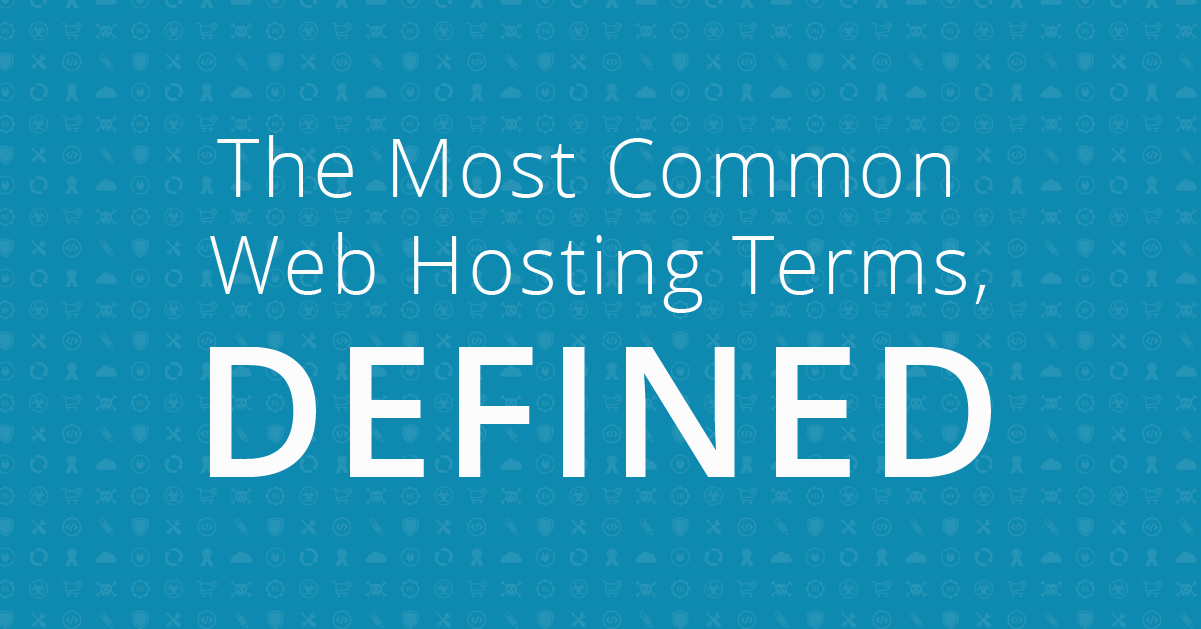Hey We get it. Setting up a website can be intimidating. And for many people, one of the biggest hurdles to getting online is simply learning to speak the language of the internet. So we’ve created a visual glossary, defining thirty-five common web hosting terms, acronyms, and phrases (we’ve also included a text-only version at the bottom of this post).
That’s right, you’ve just unlocked a “techspeak achievement.” Time to level up or, in this case, start a website.

More Web Hosting Terms
In the fast-paced world of online business, understanding web hosting terms is essential for establishing and growing your digital presence. Whether you’re a seasoned entrepreneur or an online newbie, this comprehensive web hosting glossary is for you.
After learning these web hosting terms, you’ll be equipped with the knowledge to communicate fluently online and make progress in business. From shared hosting to SSL certificates, let’s dive into the world of web hosting and unlock the potential for success.
24/7 Customer Support: Reliable web hosting providers offer round-the-clock customer support to address technical issues, provide assistance, and resolve hosting-related inquiries. 24/7 support ensures prompt help whenever it’s needed.
Bandwidth: The amount of data that can be transferred to or from your website each second.
Blog: A regularly updated website or web page. New entries are called posts; posts can be used to drive business to your site or help with SEO.
Cloud hosting: Cloud hosting mirrors your data across multiple storage devices instead of having it reside on just one machine. This redundancy ensures reliability for your site.
CDN: A content delivery network (CDN) is a system of servers distributed across multiple data centers around the world that delivers web content, specifically static files like your website’s images and page styles, to end users.
Control panel: The control panel is the nerve center of your Bluehost account. This is where you can add new domains, create email addresses, install applications, and manage behind-the-scenes settings.
CMS: A content management system (CMS) is a user-friendly application that you install on a hosting server to make managing a website easier. A CMS is particularly great for people without a coding background to get started with a website. CMS is one of the most popular web hosting terms.
CPU: The central processing unit (CPU) is the brains of your server or computer, executing commands, making decisions, and doing the input/output calculations.
Data center: A data center is a specialized facility that houses thousands of servers that are connected via a network to the Internet.
DDoS Protection: DDoS (Distributed Denial of Service) protection safeguards websites against massive traffic floods from multiple sources, aiming to overwhelm the server and make the site inaccessible. DDoS protection measures detect and mitigate these attacks, ensuring uninterrupted website availability.
Dedicated hosting: Dedicated hosting allows you to lease an entire server for your use rather than sharing it with other users or organizations.
Disk Space: Disk space represents the storage capacity allocated for website files, databases, emails, and other content. It determines the amount of data you can store on the hosting server. Different hosting plans offer varying levels of disk space.
DNS: The Domain Name System (DNS) translates easy-to-remember domain names to numerical IP addresses.
Domain name: A domain name, like Bluehost.com, is used to identify the location of a particular web page.
Domain registrar: A domain registrar is a company accredited by the Internet Corporation for Assigned Names and Numbers (ICANN) to register and manage domain names.
E-commerce: E-commerce is the practice of buying and selling products or services online.
FTP and SFTP: File Transfer Protocol (FTP) and Secure File Transfer Protocol (SFTP) are used to transfer files between a computer and a server. FTP is especially useful for bulk transfers, so you don’t have to move hundreds of files individually.
HTML: HyperText Markup Language (HTML) is a computer language that tells your browser how to display a web page.
HTTP: HyperText Transfer Protocol (HTTP) is an application protocol for transferring files on the web. Think of it as the foundation of the internet.
HTTPS: HyperText Transfer Protocol Secure (HTTPS) is the use of HTTP over a secure connection, most commonly in conjunction with Transport Layer Security (TLS).
IP address: Each internet-connected computer has at least one IP address, a unique sequence of numbers and/or letters, that serves two purposes: host or network interface identification (who it is) and location addressing (where it is).
Malware: Although not strictly a web hosting term, malware is very important in servers. Harmful software that aims to damage, disable, or take control of your computer, mobile device, website, or network. Malware is often used to steal information or hold data for ransom.
Migration: Migration refers to the process of transferring a website from one hosting provider or server to another. A smooth migration involves moving all website files, databases, configurations, and settings without causing downtime or data loss.
Parked Domain: For Bluehost customers, a parked domain is a special feature available in the control panel that allows you to have a new domain display the same content as one of your other domains. Outside of cPanel hosting, a parked domain is a domain name that has been registered but isn’t currently pointing to a website. Organizations often park domains for future use or to ensure they aren’t registered by other buyers.
Payment Gateway: A payment gateway is a service that allows users to authorize credit card payments for e-commerce. Payment gateways often have specific compliance requirements based on your business type and transaction volume.
PHP: PHP (a backronym for Hypertext Preprocessor) is a scripting language designed for web development. It combines dynamic content — prices, comments, or shopping cart contents — with static content — page styles and images — into HTML so your browser can display it.
Plugin: A plugin is a software component that allows you to add a specific feature or function to an existing web program like WordPress.
RAM: Random access memory (RAM) is where your server or computer stores the short-term data it needs to access regularly or quickly.
Scalability: Scalability refers to the ability of a hosting environment to handle increasing website traffic and resource demands. A scalable hosting solution can adapt and accommodate growth without compromising performance or user experience.
Server: A server is a powerful computer designed for a specific task. It is among the most important web hosting terms. Web hosting servers are programmed to serve up web content. To ensure reliability and performance, unneeded components are removed, so most servers don’t have video cards, monitors, or even a keyboard.
Server-side Scripting: Server-side scripting involves executing code on the webserver to generate dynamic web pages. Programming languages like PHP, Python, and Ruby are commonly used for server-side scripting, enabling the creation of interactive and data-driven websites.
Shared hosting: Shared hosting is when your website resides on a server alongside other people’s sites. The server’s available resources are shared by all the sites.
Site Backup: Site backup is the practice of copying and archiving data so that you can restore your site in the event of a system failure, cyber attack, or human error.
SSL and TLS: A Secure Sockets Layer (SSL), the predecessor of Transport Layer Security (TLS), is an encryption protocol designed to secure connections between computer systems. For convenience and legacy reasons, both protocols are often referred to as SSL.
SSL certificate: An SSL certificate is used to provide third-party validation of your encryption key, so someone else can’t pretend to be your website. Bluehost customers can purchase an SSL certificate in their control panel.
Subdomains: Subdomains allow you to add a prefix to your domain name (for example, help.bluehost.com) to create an easy-to-remember URL for specific content without having to register additional domains.
TLDs: Top-level domains (TLDs) are the suffixes, such as .com, .space, and .website, at the end of every web address.
Uptime: The amount of time the server is uninterrupted and your website is accessible. This can be measured linearly (154 days uptime) or as a percentage (99 percent uptime over the last year).
Virus: A virus is malware that self-replicates by infecting other programs, servers, or home computers. Viruses are commonly transmitted through email.
VPS: A virtual private server (VPS) is a web hosting server that is partitioned into sections that act as virtual dedicated servers, with each being assigned to only one user at a time.
Web hosting service: A web hosting service provides server space so individuals and businesses can make websites accessible on the internet. DaManager is a web hosting service among other great providers.
Conclusion
There are certainly more web hosting terms you can find if you research further. However, you can successfully communicate with all parties you have to interact with in the web hosting industry with these terms we you have just learned.
Take some time to practice using these words. Feel free to return to this post if you need to remind yourself of some web hosting terms.
This article was originally published in 8 December 2017. It was most recently updated in July 13, 2023 by























